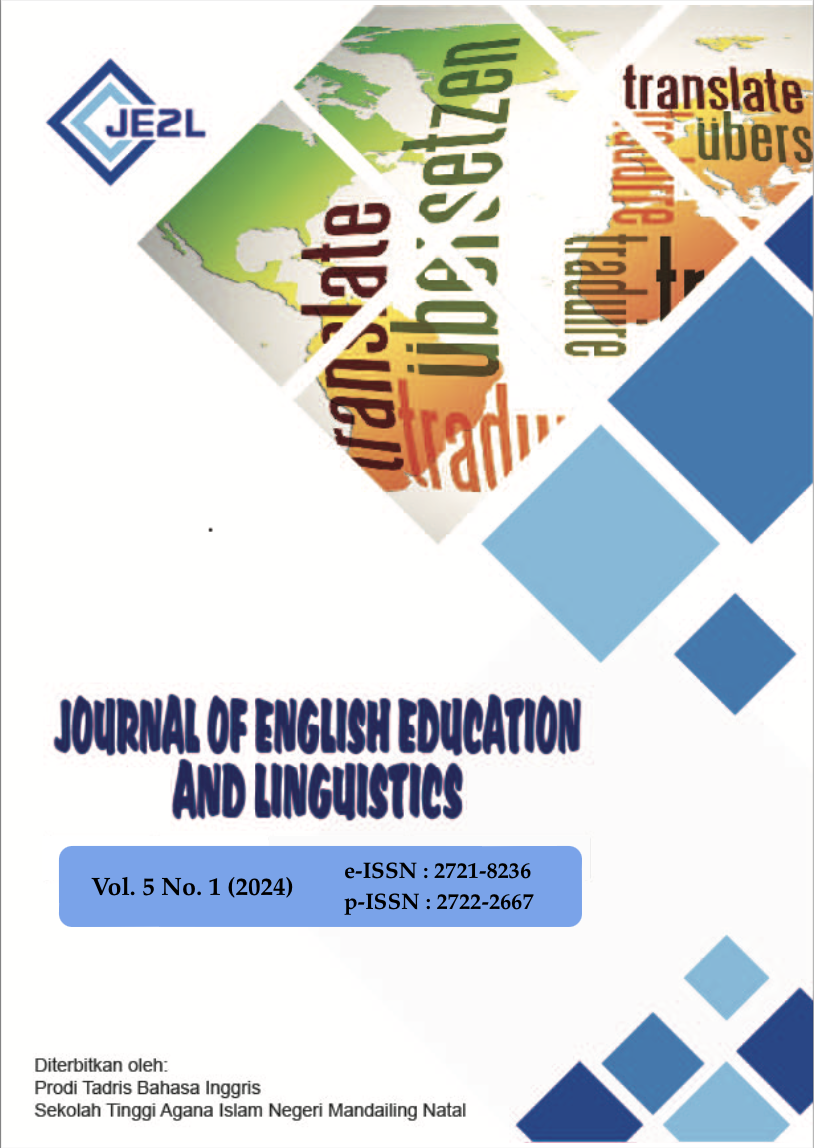CONSTRUCTION OF RECIPROCAL VERBS IN ANGKOLA BATAK LANGUAGE
DOI:
https://doi.org/10.56874/jeel.v5i1.1739Keywords:
Reciprocal verbs, Angkola Batak language, binding theory, syntax, morphologyAbstract
This research aims to analyze the syntactic aspects of reciprocal verb construction in the Angkola Batak language (ABl) using binding theory. A qualitative method with a descriptive approach is used in this research. Data were collected through literature study and the author's intuition as a native speaker, then analyzed by agih method and presented informally and formally. The result of the research identifies the formation process of reciprocal verbs in ABl through affixation, affixation+reduplication, and affixation+the word "saling". The characteristics of reciprocal verbs in ABl include intransitive nature, can be followed by the constituent "each other", requires the presence of subject-filling nouns or human complements, and belongs to the category of telic verbs. This study concludes that the binding theory can be applied to analyze the construction of reciprocal verbs in the Angkola Batak language, showing the validity of this theory in the analysis of regional languages. The contribution of this research lies in the documentation and understanding of the grammatical aspects of the Angkola Batak language.
References
Amriwati, R. & Agustina, N. (2018). Verba Resiprokal Dalam Bahasa Minangkabau Di Kecamatan Patamuan Kabupaten Padang Pariaman. Jurnal Bahasa Dan Sastra, 5(2). https://ejournal.unp.ac.id/index.php/ibs/article/view/9613
Lasnik,H.(2006). Government–Binding Theory. https://doi.org/10.1002/0470018860.S00218.
Handayani, Sri. (2011). Resiprokalitas Verba dalam Bahasa Jawa (Disertasi). Surakarta: Program Pascasarjana Universitas Sebelas Maret.
Hutapea, Nicco Erianto. (2008). Diatesis dalam Bahasa Batak Toba (Skripsi). Medan: Fakultas Sastra USU.
Hutasuhut, A. (2008). Medan Makna Aktivitas Tangan dalam Bahasa Mandailing. Prodi Linguistik SPs USU.
Irwan. (2009). Kata Majemuk Bahasa Batak Angkola Mandailing. Prodi Linguistik SPs USU.
Kridalaksana, Harimurti, dkk. (1985). Tata Bahasa Deskriptif Bahasa Indonesia: Sintaksis. Pusat Pembinaan dan Pengembangan Bahasa, Depdikbud.
Kridalaksana, H. (1983). On Reciprocity dalam majalah linguistik- Indonesia. Masyarakat Linguistik Indonesia, 1(1).
Lubis, M. (2002). Kalimat Tanya dalam Bahasa Mandiling: Analisis Sintaksis. Prodi Linguistik SPs USU.
Mascahaya. (2004). Tindak Bahasa Permohonan dalam Bahasa Angkola. Linguistik SPs USU.
Nasution, K. (2010). Pemajemukan dalam Bahasa Mandailing. Prodi Linguistik SPs USU.
Nasution, S. M. (2001). Analisis Semantik Bahasa Mandailing. Prodi Linguistik SPs USU.
Nedjalkov, V. P. (Ed.). (2007). Reciprocal Constructions. Amsterdam: John Benjamins Publishing.
Richards, J. C. & Schmidt, R. (2013). Longman Dictionary of Language Teaching and Applied Linguistics (4th ed.). Routledge.
Subroto, E. (2007). Pengantar Metode Penelitian Linguistik Struktural. Universitas Sebelas Maret Press.
Sudaryanto. (2023). Predikat-objek dalam bahasa Indonesia: Keselarasan pola urutan [Predicate-object in Indonesian language: Harmony of sequence patterns] (2nd ed.). Penerbit Universitas Indonesia.
Sudaryanto. (2015). Metode dan Aneka Teknik Analisis Bahasa (Pengantar Penelitian Wahana Kebudayaan Secara Linguistis) (2nd ed.). Sanata Dharma University Press.
Yule, G. (2020). Pragmatics (2nd ed.). Oxford University Press
Downloads
Published
Issue
Section
License
All articles published in the Journal of English Education and Linguistics are licensed under a Creative Commons Attribution-ShareAlike 4.0 International (CC BY-SA) license. This means anyone is free to copy, transform, or redistribute articles for any lawful purpose in any medium, provided they give appropriate attribution to the original author(s) and Journal of English Education and Linguistics, link to the license, indicate if changes were made, and redistribute any derivative work under the same license.
Copyright on articles is retained by the respective author(s) without restrictions. A non-exclusive license is granted to the Journal of English Education and Linguistics to publish the article and identify itself as its original publisher, along with the commercial right to include the article in a hardcopy issue for sale to libraries and individuals.
Although the conditions of the Creative Commons Attribution-ShareAlike 4.0 International (CC BY-SA) license do not apply to authors (as the copyright holder of your article, you have no restrictions on your rights), by submitting to the Journal of English Education and Linguistics, authors recognize the rights of readers and must grant any third party the right to use their articles to the extent provided by the license.

This work is licensed under a Creative Commons Attribution-ShareAlike 4.0 International License.








